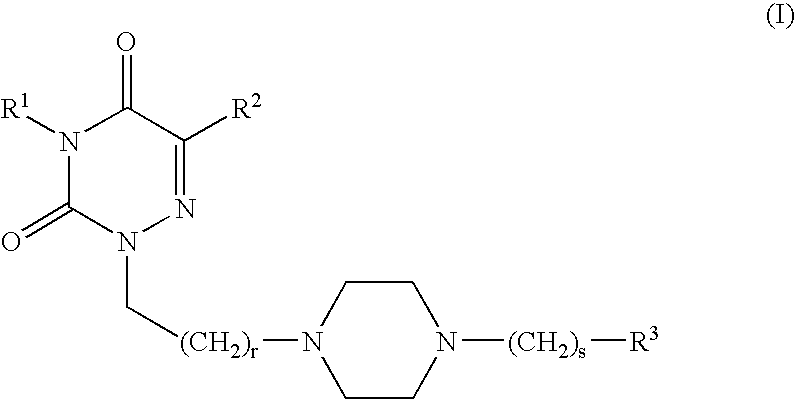Radiolabeled compounds and uses thereof
a technology of radiolabeled compounds and compounds, applied in the field of radiolabeled compounds, can solve the problems of inability to successfully use a 5-htsub>1a /sub>agonist radiotracer for studies in the living brain, and achieve the effect of stabilizing the mood of a subj
- Summary
- Abstract
- Description
- Claims
- Application Information
AI Technical Summary
Benefits of technology
Problems solved by technology
Method used
Image
Examples
example 1
Preparation of Compound A
Step A: Preparation of Intermediate Compound 15
[0179]
[0180]Amine 12 (796 mg, 5 mmol) was diluted with PEG-400 (2 mL) and to the resulting solution was added dichloroamine compound 5 (892 mg, 5 mmol). The resulting reaction was heated under microwave conditions for 10 seconds, then allowed to cool to room temperature. This heat / cool process was repeated two more times. It is noted that during the heating / cooling cycles, copious amounts of hydrochloric acid gas is released. After the evolution of hydrochloric acid gas subsided, the reaction mixture was triturated using chloroform to precipitate out a crude solid residue. The crude solid residue was filtered and washed with chloroform. The washed solid was then recrystallized from chloroform:methanol to provide compound 13 in 54% yield. 1H NMR (CDCl3, 400 MHz) δ 7.80 (d, J=11.6 Hz, 1H), 7.62 (d, J=8.1 Hz, 1H), 7.53-7.54 (m, 1H), 7.30 (m, 1H), 7.22 (s, 1H), 7.15-7.20 (m, 1H), 3.60 (t, J=6.8 Hz, 4H), 3.39-3.41 (m...
example 2
Preparation of Compound B
Step A: Preparation of Intermediate Compound 17
[0184]
[0185]Piperazine compound 16 (150 mg, 0.84 mmol, commercially available) and chloride compound 14 (183 mg, 0.84 mmol, commercially available) were diluted with n-butanol (5 mL) and to the resulting solution was added triethylamine (0.5 mL, added drop wise). The resulting reaction was heated and refluxed for about 12 hours, allowed to cool to room temperature, then concentrated in vacuo to provide a crude residue. The crude residue was triturated using diethyl ether and the resultant off-white precipitate was filtered, washed with diethyl ether (50 mL) and purified using flash column chromatography on silica gel (mobile phase was gradient of 5% to 10% methanol in dichloromethane) to provide precursor compound 17 as a colorless solid (220 mg, 73%). m.p=162-64° C., 1H NMR (300 MHz, CDCl3): δ 7.35 (s, 1H), 7.0 (m, 1H), 6.4 (d, 1H, J=8.16), 6.2-6.3 (2H, m), 4.0 (t, J=7 Hz, 2H), 3.3 (s, 3H), 3.14-3.15 (m, 4H), 2...
example 3
Preparation of Compound C
Step A: Preparation of Intermediate Compound 19
[0187]
[0188]Intermediate compound 19 was made using the method described in Example 1, Step A, and substituting Compound 18 for Compound 13. Compound 18 can be made using the method set forth in Example 5.1, Step A, and substituting 8-amino-1-naphthol for Compound 12.
Step B: Radiolabeling of Compound 19 to Provide Compound C:
[0189]
[0190]Compound C was made using the method described in Example 5.1, Step B, and substituting Compound 19 for Compound 15. 1H NMR (300 MHz, CDCl3): δ 7.7 (s, 1H), 7.3-6.8 (m, 4H), 4.2 (t, 2H), 3.3 (s, 3H), 2.9 (m, 4H), 2.6 (m, 4H), 2.4 (t, 2H), 1.8 (m, 2H), 1.6 (m, 2H). HRMS calcd for C18H26O3N5 (MH+): 360.2036. Found: 360.2032.
PUM
| Property | Measurement | Unit |
|---|---|---|
| flow rate | aaaaa | aaaaa |
| radioactive emission | aaaaa | aaaaa |
| neurological disorder | aaaaa | aaaaa |
Abstract
Description
Claims
Application Information
 Login to View More
Login to View More - R&D
- Intellectual Property
- Life Sciences
- Materials
- Tech Scout
- Unparalleled Data Quality
- Higher Quality Content
- 60% Fewer Hallucinations
Browse by: Latest US Patents, China's latest patents, Technical Efficacy Thesaurus, Application Domain, Technology Topic, Popular Technical Reports.
© 2025 PatSnap. All rights reserved.Legal|Privacy policy|Modern Slavery Act Transparency Statement|Sitemap|About US| Contact US: help@patsnap.com



